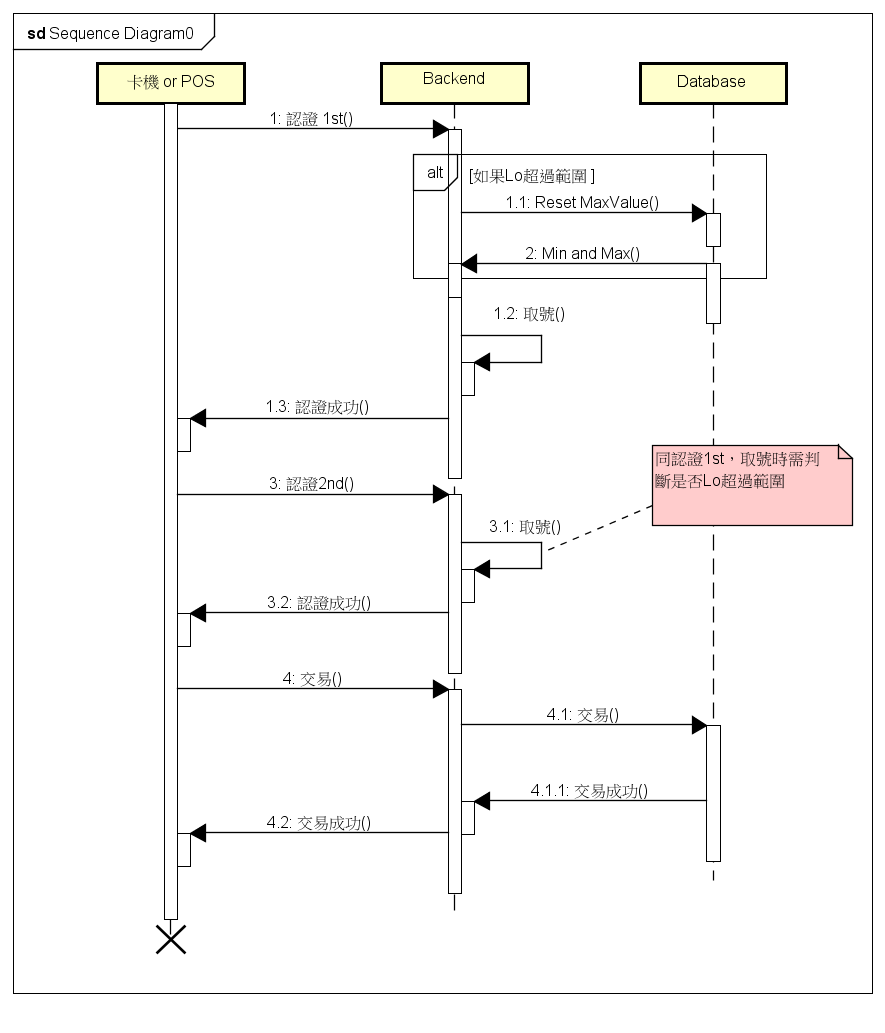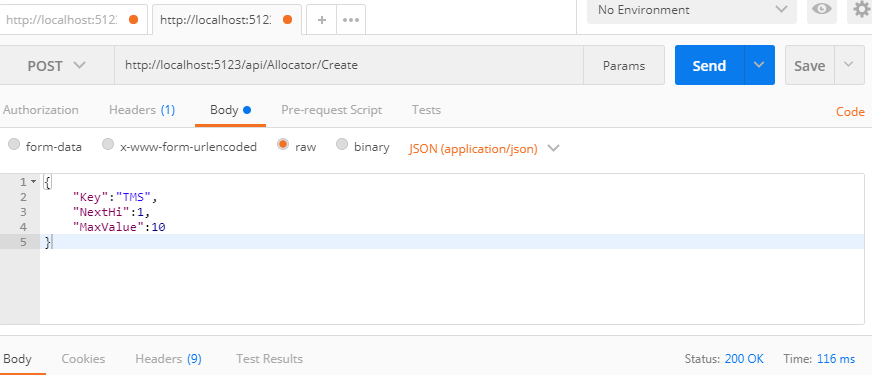線性分配器(Linear Block Allocator)與高低位分配器(Hi/Lo allocator)皆是在不需要頻繁與後端連線的情況下取得一組Unique number。
作法為在後端(此例指資料庫)先指定一個範圍值給 Hi,例如1001 - 1999 ,然後在應用程式設定一個Singleton物件並記錄這個範圍值,每次取號時就從這個範圍逐一取一個號碼出來,也就是lo。 當這個範圍取完之後,再向後端要一個新的範圍來用。
使用的情景為,當我們的AP需要快速回應,並且夾帶一個唯一的序號時,那麼就可以透過Allocator很快的取得一組已經分配好的序號。
線性分配器所分配的範圍會連號,但是Hi-Lo則不會。本文章將採用線性分配器來實作。
在一個線上過卡交易的系統中,系統在傳送實際交易前,會送兩次認證的請求(Http Request),Server必須分別回應包含唯一序號的認證成功訊息。
但我們不希望這兩次認證請求拖慢整體交易時間,因此採用線性分配器來降低取得序號的時間。
以循序圖表示:

這是個標準取號的Singleton需求;另外我們也可以透過ASP.NET Core強大的DI機制來注入並使用Singleton物件。
這個範例程式碼需要使用到Sql Server資料庫,請先查看README的步驟。
我們將利用ASP.NET Core Web API實作以下功能:
[Table("HiLos")]
public class HiLo
{
[Key]
[StringLength(200)]
public string Key { get; set; }
[Required]
[Column(TypeName="bigint")]
public Int64 NextHi { get; set; }
[Required]
[Column(TypeName="bigint")]
public Int64 MaxValue { get; set; }
}
另外我們建立一個前端取號的DTO:
public class Sequence
{
public string Key { get; set; }
public long Value { get; set; }
}
這個Facade類別主要負責提供介面來建立一個新的取號器,以及取得下一個號碼。
但我們先實作建立取號器的方法:CreateHiLoInstance(HiLo hl, out bool isKeyExist)
public class AllocatorManager : IDisposable
{
private DbContextFactory _dbFactory = null;
public AllocatorManager(DbContextFactory dbFactory)
{
this._dbFactory = dbFactory;
}
///建立一個新的取號器
public void CreateHiLoInstance(HiLo hl, out bool isKeyExist)
{
isKeyExist = false;
using (var hlService = new HiLoService<HiLo>(this._dbFactory.CreateDbContext()))
{
isKeyExist = hlService.GetAll().Any(x => x.Key.Equals(hl.Key));
if (!isKeyExist)
{
hlService.Add(hl);
}
else
{
isKeyExist = true;
}
}
}
/// 取得下一個號碼
public Domain.Models.Sequence GetNextVal(string key)
{
throw new NotImplementException();
}
}
另外程式中在DAL(Data Access Layer)使用了Unit Of Work pattern,所以會有利用var hlService = new HiLoService<HiLo>(this._dbFactory.CreateDbContext())
來新增資料的寫法。
UOW Pattern可以參考Tom Dykstra的文章:Implementing the Repository and Unit of Work Patterns in an ASP.NET MVC Application
[Route("Create")]
[HttpPost]
public async Task<HttpResponseMessage> Create([FromBody]HiLo hilo)
{
if (hilo == null)
{
return new HttpResponseMessage(HttpStatusCode.BadRequest);
}
else
{
using(var dbFactory = new DbContextFactory(this._env.EnvironmentName))
using(var allocatorMng = new AllocatorManager(dbFactory))
{
bool isKeyExist = false;
allocatorMng.CreateHiLoInstance(hilo, out isKeyExist);
}
return new HttpResponseMessage(HttpStatusCode.Created);
}
}
實際利用Postman建立一個分配器:

取號的部分我們明天再來實作。
